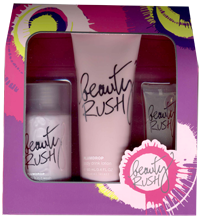Ten
Synthetic Cosmetic Ingredients to Avoid
Article
by BudwigDVDs.com

This
article started with a trip to the Mall. My
niece (8) had asked me for glittery lip-gloss
and lotions from Victoria's Secret for her
birthday. She knows I don't enjoy shopping
for cheap cosmetics but I decided to just
go anyways and "get what she asked for". Since
she can now read, I planned to attach a flyer
with a list of all the synthetic ingredients
I knew I was bound to find in such cheap non-natural
cosmetics. But to my surprise, it was worst
than I thought...
I
compared the ingredients with the list of
"Ten Synthetic Cosmetic Ingredients to Avoid"
by Aubrey Hampton and was surprised to actually
find 9 out of the 10. Here
is the breakdown plus I did some extra work
and attached pictures. This was a great lesson
to my niece. I hope this article will help
you as well and inspire everyone to search
out for unhealthy ingredients.
Learn
to read labels, and refuse to settle
for half-natural hair and skin care.
Buy only organic and all-natural
products. Plus there are plenty
of wonderful choices available nowadays.
|
|
|
1.
METHYL, PROPYL, BUTYL AND ETHYL PARABEN
These are used as inhibitors of microbial
growth and to extend shelf life of products.
They have caused many allergic reactions
and skin rashes. Studies have shown
that they are weakly estrogenic and
can be absorbed by the body through
the skin. They are widely used even
though they are known to be toxic.
|
|
2.
DIETHANOLAMINE (DEA), TRIETHANOLAMINE
(TEA)
These are often used in cosmetics as
emulsifiers and/or foaming agents. They
can cause allergic reactions, eye irritation
and dryness of hair and skin. DEA and
TEA are "amines" (ammonia
compounds) and can form cancer-causing
nitrosamines when they come in contact
with nitrates. They are toxic if absorbed
into the body over a long period of
time. |
|
3.
DIAZOLIDINYL UREA, IMIDAZOLIDINYL UREA
These are widely used preservatives.
The American Academy of Dermatology
has found them to be a primary cause
of contact dermatitis. Two trade names
for these chemicals are Germall II and
Germall I15. Neither of the Germall
chemicals contains a good anti fungal
agent, and they must be combined with
other preservatives. Both these chemicals
release formaldehyde, which can be toxic. |
|
4.
SODIUM LAURYL/LAURETH SULPHATE
This is a cheap, harsh detergent used
in shampoos for its cleansing and foam-building
properties. Often derived from petroleum,
it is frequently disguised in pseudo-natural
cosmetics with the phrase "comes
from coconuts". It causes eye irritation,
scalp scurf similar to dandruff, skin
rashes and other allergic reactions. |
|
5.
PETROLATUM
Also known as petroleum jelly, this
mineral oil derivative is used for its
emollient properties in cosmetics. It
has no nutrient value for the skin and
can interfere with the body's own natural
moisturizing mechanism, leading to dryness
and chapping. It often creates the very
conditions it claims to alleviate. Manufacturers
use petrolatum because it is unbelievably
cheap. |
|
6.
PROPYLENE GLYCOL
Ideally this is a vegetable glycerin
mixed with grain alcohol, both of which
are natural. Usually, it is a synthetic
petrochemical mix used as a humectant.
It has been known to cause allergic
reactions, hives and eczema. When you
see PEG (polyethylene glycol) of PPG
(polypropylene glycol) on labels, beware
- these are related synthetics. |
|
7.
PVP/VA COPOLYMER
A petroleum derived chemical used in
hairsprays, styling aids and other cosmetics.
It can be considered toxic, since inhaled
particles can damage the lungs of sensitive
people. |
NOT
CONTAINED IN PARTICULAR PRODUCT |
8.
STEARALKONIUM CHLORIDE
A quaternary ammonium compound used
in hair conditioners and creams. Developed
by the fabric industry as a fabric softener,
it is a lot cheaper and easier to use
in hair conditioning formulas than proteins
or herbals, which are beneficial to
the hair. Causes allergic reactions.
Toxic. |
|
9.
SYNTHETIC COLOURS
Used to make cosmetics "pretty",
synthetic colors, along with synthetic
hair dyes, should be avoided at all
costs. They will be labeled as FD&C
or D&C, followed by a color and
a number. Example: FD&C Red No.6/D&C
Green No.6. Many synthetic colors
can be carcinogenic. If a cosmetic
contains them, don't use it.
[I found a handful of synthetic colors
like yellows, oranges, reds, green,
blues and more.]
|
|
10.
SYNTHETIC FRAGRANCES
The synthetic fragrances used in cosmetics
can have as many as 200 ingredients.
There is no way to know what the chemicals
are, since on the label it will simply
read "fragrance". Some problems
caused by these chemicals include headaches,
dizziness, rash, hyper pigmentation,
violent coughing, vomiting, skin irritation
- the list goes on. Advice: Don't buy
a cosmetic that has the word "fragrance"
on the ingredients label.
|
References:
"Natural
Ingredients Dictionary" by Aubrey Hampton
Images
of Victoria's Secret Beauty Rush Product
|